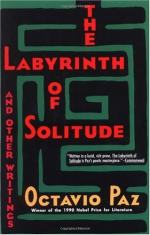
|
| Name: _________________________ | Period: ___________________ |
This test consists of 5 multiple choice questions, 5 short answer questions, and 10 short essay questions.
Multiple Choice Questions
1. As Paz uderstands it, what is the Mexican's relation to death?
(a) Sacrificial.
(b) Intimate but empty.
(c) Emotionally remote.
(d) Intimate and heartbreaking.
2. What do a pachuco's actions and lifestyle demonstrate?
(a) His desire to return to Mexico.
(b) His dissatisfaction with North American culture.
(c) His anger at a culture that will not assimilate him.
(d) His will to remain different.
3. How do Mexicans avoid the dangers of romantic relationships, according to Paz?
(a) By not truly loving.
(b) By stifling their feelings.
(c) By exaggerating their feelings.
(d) By denying the importance of the other.
4. In their relation to their world, to whom does Paz compare Mexicans?
(a) Orientals.
(b) Peruvians.
(c) Germans.
(d) Nigerians.
5. What model do Mexicans prefer that the woman follow?
(a) The model of The Virgin Mary - chaste and kind.
(b) The model of ancient Mexican goddesses.
(c) A general model of decency, secrecy, and long-suffering.
(d) A model of strength, praise, and fortitude.
Short Answer Questions
1. How does the philosophy of progress treat death?
2. According to Paz, how does death end when a civilization denies it?
3. Paz states that a Mexican utters the words that are considered most evil when which of the following occurs?
4. Why did Catholicism drastically change the Aztec view of life?
5. During the fiesta of Grito, why do the people shout for one hour, in Paz's interpretation?
Short Essay Questions
1. How does Mexico's poverty relate to the fiesta? What French interpretation did it inspire?
2. Why does the Mexican love Form? Other than in personal relationships, how does that idea express itself?
3. What group of people did the author have in mind as he wrote the book? How and why did those people become important to him?
4. How is the modern murderer different from a murderer of the past? How has modernity contributed to that difference?
5. How does Paz explain the Mexican woman's role in society? How does that strip her of her personality?
6. What is dissimulation? How does it compare to lying? How does it affect the Mexican's idea of himself?
7. How do Mexicans view their bodies? How does their view contribute to their wish for privacy?
8. "The pachuco has lost his whole inheritance: Language, religion, customs, and beliefs. He is left with only a body and a soul with which to confront the elements" (Chapter One, pg 15). Is that a true statement?
9. What happens during the fiesta? What is the emotional result?
10. According to Alarcon, why does the liar lie to himself? Given what you know of the Mexican mindset, does that make sense?
|
This section contains 1,745 words (approx. 6 pages at 300 words per page) |

|




